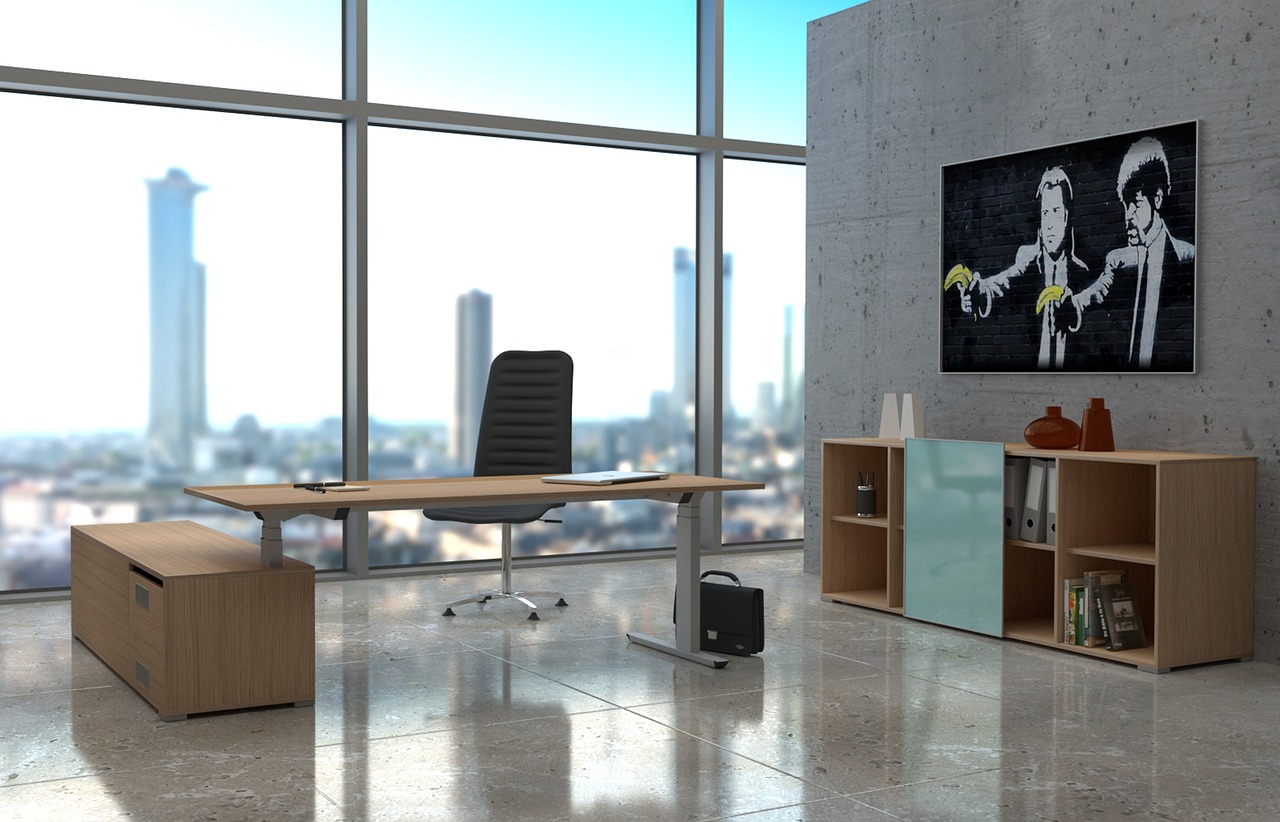By Claudia Schnugg and Johannes Lehner
Art can be beautiful and demanding, it can induce aesthetic pleasures, represent values and ideas or challenge ways of seeing. These personal experiences with art allow individuals to communicate their identity with the artworks they like. But artworks as decoration of offices do not only communicate identity, they also point to status.
Contemporary artworks of renowned artists are decorating the wall and this media art sculpture is seducing the visitors before they find their way around in the foyer, maybe they already passed a sculpture on their way into the building. Scenes like this at the entrance of a corporation, a bank or an insurance company are no exceptions. The same is true for offices: individuals want to make their office a personal space, but especially for managers and executives the office is a space of representation. Not only furniture, dimensions of the space and the location of their office in the building are emphasizing their position in the organization, but also the additional objects managers accumulate point to their status. And so do the artworks they display there.
Art plays a significant role in the world of representation in business. Already rich merchant families in the Renaissance age liked to surround themselves with artworks, just alike aristocrats. Since then, managers and politicians like to present themselves amidst artworks, in their offices and on press photos. And this representational character adds this twist of rather communicating status than personal identity to the artwork in the office. Suddenly, the managers’ taste in art is exhibited to an audience that has to gain a certain impression of the individual and thus managers often choose carefully in front of which artwork they want to sit.
In our study, we investigated how managers use artworks to create a certain atmosphere in their offices or on their press photos. The symbolic value of artworks can be conveyed by a certain aesthetic, the depicted objects or symbols, its visible origin from a certain culture or society, or through the style it is painted in, and for those knowing art’s historical details, by the artist who created it. This shows that even choosing artworks as “pure” decoration will influence the atmosphere of the room and thus say something about the identity of the owner. Knowledge about the art market and of art history will enable some visitors of the office to decipher personal preferences, beliefs and ideas of the manager who owns this artwork. But what about individuals with no background knowledge in art? Why would a manager pay high prices on the art market to present something to the employees or clients?
There must be more than displaying the own or the organization’s identity by placing artworks in offices and on press photos. Artworks do not only contribute to creating an idea of beliefs and ideals, but also contribute to a certain atmosphere in a room which also contributes to a certain status of the owner, as art theorist Boris Groys argues: just as rich merchant families in the Renaissance tried to heighten their status by artworks in order to symbolize equality with aristocracy. In this stream of thoughts, buying and positioning artworks in semi-official and semi-individual spaces is a form of conspicuous consumption. This concept developed by the sociologist and economist Thorstein Veblen reflects on why individuals buy luxury goods if there would be cheaper versions of the same thing. He concludes that the acquisition and display of such luxury goods is a form of representation of wealth and economic power that is recognized by all individuals in determined society. More generally speaking, conspicuous consumption is an act of status behavior because these luxury goods symbolize status.
The aspect of conspicuous consumption and status behavior does not exclude the possibility that a piece of art might simultaneously serve the communication of identity and status. We explored when and whether one of the two functions is dominant by analyzing portraits of managers in their office environment which are published in the Austrian, German and American manager magazines Trend, WirtschaftsWoche, and Fortune. We show that portraits with artworks in the back of managers played a significant role in their representation: Managers who are photographed within their office surrounding tend to position themselves close to an artwork. There is a difference between managers of companies that are associated with products or with services, though. Our study indicates that managers in industries that are not focused on production, but on services like finance and insurance, significantly differ regarding the need to express organizational identity versus status. When managers of production companies are often depicted in front of their products or production halls, managers from the service sectors tend to present themselves in office spaces with artworks. Our study also hints at a difference between abstract artworks and figurative ones. Managers of production companies might also be depicted in front of artworks that symbolize the organization’s product, whereas managers from service companies often are depicted in front of abstract paintings and sophisticated sculptures. A starting point for more research in this area is the differentiation of meaning between the different kinds of artworks: artworks that depict objects and people might say more about identities – individual and organizational ones – than very abstract paintings, as objects are easier to read than styles or other characteristics. Such artworks which are not that easily readable for wider audiences might be preferred to express status as they create ambiguity. Situations of high ambiguity are ideal for demonstrating power and status, as ambiguity requires interpretation which the owner of the artwork seems to be able to provide.
This article is based on:
Schnugg, Claudia A. and Lehner, Johannes M. (2016): “Communicating Identity or Status? A Media Analysis of Art in Executives’ Photographed Portraits” International Journal of Arts Management 18(2): 63-74.
Other References:
Groys, B. 1999. “Kunst als Avantgarde der Ökonomie.” Pp. 19–26 in Die Kultur-AG: Neue Allianzen zwischen Wirtschaft und Kultur, edited by A. Grosz and D. Delhaes. München, Wien: Hanser Verlag.
Veblen, Thorstein. 1912. The Theory of the Leisure Class: An Economic Study of Institutions. New York: The Macmillan Company.
Authors:
Claudia A. Schnugg is independent researcher in intersections of art and aesthetics with science, technology, and business, and producer of art and science collaboration. Claudia holds a PhD in social and economic sciences from the University of Linz. Her doctoral dissertation was designed as an interdisciplinary work at the Johannes Kepler University, Linz, and the University of Art and Design, Linz.
Johannes M. Lehner is Associate Professor at Johannes Kepler University Linz, Institute for Organization and Global Management Education. His research currently focuses on status behaviour, forming of implicit organizations and project management.
Image by: Purple Juice Graphics (https://pixabay.com/de/office-büro-skyscraper-hochhaus-1590844/)







